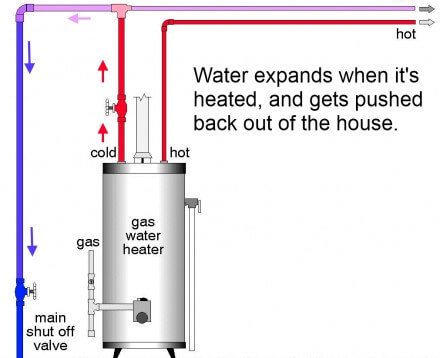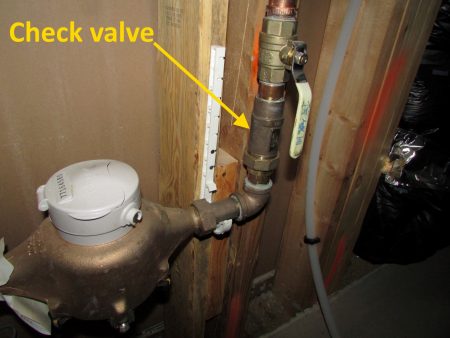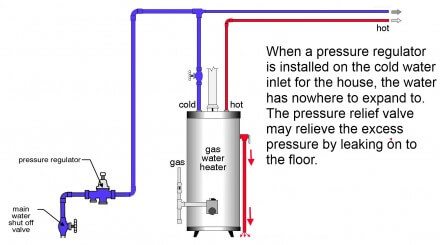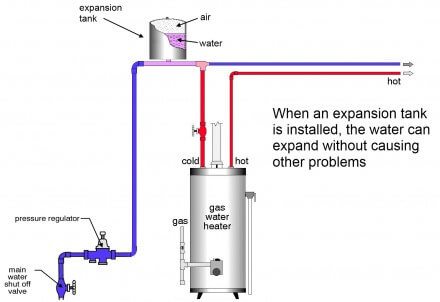When a water heater is connected to a closed system, an expansion tank must be installed to prevent excessive pressure in the water. To help understand what this is all about, please read on.
Why most Minnesota homes don’t have a problem with excessive water pressure
When a water heater fires up, the water in the tank expands. When this happens, where does the water go? Right back out the cold water inlet, all the way back to the water supply coming into the house. The municipal water supply for the house acts as a gigantic expansion tank… and nobody notices. This is illustrated in the diagram below.
Closed systems are different
What happens when a one-way valve, or check valve, gets installed on the water supply piping for the house?
The water has nowhere to go. As the water heater heats the water, it expands, which builds up pressure. When the pressure builds up enough, the temperature and pressure relief valve on the water heater simply does its job. It relieves the excess pressure by leaking a little bit of water.
Here’s a short video clip showing this happening:
This doesn’t happen every time that a pressure reducing valve or check valve is installed, but there may be other problems that show up in the house, such as the toilet fill valves randomly re-filling toilets, or faucets chronically dripping.
In Minnesota, it’s rare for a check valve to be installed on the water supply line for the house, but it’s fairly common to have a pressure regulator installed. The problem that these regulators can create is that they will act as a check valve; they’ll allow water into the home, but they won’t allow water back out. This creates what is called a ‘closed system’.
Expansion tank to the rescue
When a closed system exists on the water distribution piping in a home, an expansion tank needs to be installed somewhere on the plumbing system. This is a fairly simple and straightforward fix; an expansion tank will give the water somewhere to go when it expands, and the temperature and pressure relief valve on the water heater will stop causing problems.
This rule also applies to hot water heating systems; when a boiler heats the water in a hydronic heating system, the expansion tank allows for the water to expand without the pressure relief valve leaking. If the pressure relief valve on a boiler system chronically leaks, even after replacement, it probably means there is a problem with the expansion tank.
Is an expansion tank required, or simply a good idea?
Expansion tanks are required by any time that a closed system exists, both by water heater manufacturers and by the plumbing code. The Minnesota State Plumbing Code requirements can be found under chapter 6. Section 608.2 requires an expansion tank when a pressure regulator is installed:
An approved expansion tank shall be installed in the cold water distribution piping downstream of each such regulator to prevent excessive pressure from devleoping due to thermal expansion and to maintain the pressure setting of the regulator.
Section 608.3 requires an expansion tank when a check valve or backflow preventer is installed on the water supply line:
A water system provided with a check valve, backflow preventer, or other normally closed device that prevents dissipation of building pressure back into the water main shall be provided with an approved, listed, and adequately sized expansion tank or other approved device having a similar function to contrl thermal expansion.






John Klein
September 19, 2017, 5:51 am
What is a “closed system”?
Do you consider that to be a home on well water?
Reuben Saltzman
September 19, 2017, 9:09 am
Hi John,
A closed system is one that won’t let water out the same way it came in. A well does not create that condition.
bill
September 19, 2017, 11:15 am
even if a well had some sort of back flow preventer, don’t they all have expansion tanks to store the pumped water?
Reuben Saltzman
September 19, 2017, 12:48 pm
Yes, good point.